#fictional classification
Text
We're doing a "Get to Know Me" tag game based off of my fictional classifications :)
Basically a list of where you fit in some of the most popular and/or your favorite fictional worlds.
I figured out mine by taking online quizzes from different quiz sites to come to a general conclusion, but you can do whatever you want!
Hogwarts House: Ravenclaw
Divergent Faction: Candor
Hunger Games District: District 2, Masonry
ACOTAR Court: Day Court
Exy Position: Backliner
Godly Parent: Apollo
Winx Power: Nature
Weapon: Bow and Arrow; Magic
Superhero Team: The Titans
Feel free to reblog with your own fictional classifications! Use the examples I provided or ignore them and add your own! Just have fun :)
@that-one-bi-wizard @teddy06
#tag game#fictional classification#harry potter#divergent#the hunger games#winx club#fate of the winx#riordanverse#percy jackson and the olympians#all for the game#the foxhole court#acotar#a court of thorns and roses#titans#dc titans
43 notes
·
View notes
Text
Finally done with work for the weekend, and I MEAN IT THIS TIME! Tomorrow is a PJ, stay in bed, order in, write lots of cute shit kinda day.
Stay tuned to see if this ACTUALLY happens this time 🤞🤞
#stranger things#ao3#fandom#insomniacwriter17#the little buddy universe#billy hargrove#steve harrington#harringrove#age regression#caregiver!steve harrington#little!billy hargrove#classification au#nsap#writing#fan fiction#evie rambles
18 notes
·
View notes
Text
I’m bored, here’s a fictional Liner

Her name is the U.S.M.S Georgian*
She was built for the American Star Line (fictional line I made) in 1925 and was bombed and sunk in the pacific theater in WWII.
(* I was wrong, it’s SS Georgian)
#ocean liners#ocean liner#Fictional liner#shipposting#fictional history#yes U.S.M.S is a real classification#It means United States Mail Ship#At least I think it’s a real classification#I saw it on a post card of the SS City of New York calling it U.S.M.S New York#It had the RMS Windsor Castle in the background#I just checked I’m wrong
4 notes
·
View notes
Text
the weird little line between fantasy and science fiction is so fascinating to me. like, the other day I saw Gideon the Ninth on a Top 100 Sci-fi Novels list. that has actual fucking necromancers, but because it's set on multiple planets it's science fiction. similarly, Out Of The Silent Planet has all the archetypes of a fantasy allegory but with spaceships instead of magic carpets. The Illustrated Man uses a guy with magic tattoos to tell a bunch of Definitely Sci-Fi stories about space travel.
and how about "in-universe there's science but it's never explained and so basically indistinguishable from magic" soft sci-fi like This Is How You Lose The Time War?
science fiction, generally, relies on the One Big Assumption and then extrapolates from there, so where does realistic fantasy like, say, the later Grishaverse fit in, if your assumption is "some people can manipulate matter"? superhero shit runs the entire gamut from "this is plausible" to "A Wizard Did It", often in the same issue, so is that fantasy or science fiction?
and what of Star Wars?
so interesting!
#science fiction#fantasy#classification is weird#there's less a line and more...a swamp#gideon the ninth#out of the silent planet#the illustrated man#this is how you lose the time war#grishaverse#superheroes#star wars#so weird
36 notes
·
View notes
Text
how many names do i have? uhmmmm (counting on my fingers) five, not counting deadname
#trans#counting on fingers and mumbling “ollie lee micah richie” like its a magic incantation#theres a secret 5th name that i stole from a fictional character#ITS NOT EVEN HIS NAME! HE DOESBT HAVE A NAME AND ITS JUST WHAT THE FANDOM CALLS HIM AS AN ABBREVIATION OF HIS LONGER CLASSIFICATION#anyone that can guess where i stole two of my names from gets a shiny token#of course you have blue hair and pronouns#irl i do have blue hair and pronouns actually#dm me for my secret 5th name (winking)(with rizz)
3 notes
·
View notes
Text
My Ultimate Fictional Classification
Special thanks to @mkagemtr, @darkkangeel, and @unicornlandsposts for adding Grishaverse to this TikTok trend.
Hogwarts House (Harry Potter)

2. Faction (Divergent)

3. Panem District (The Hunger Games)
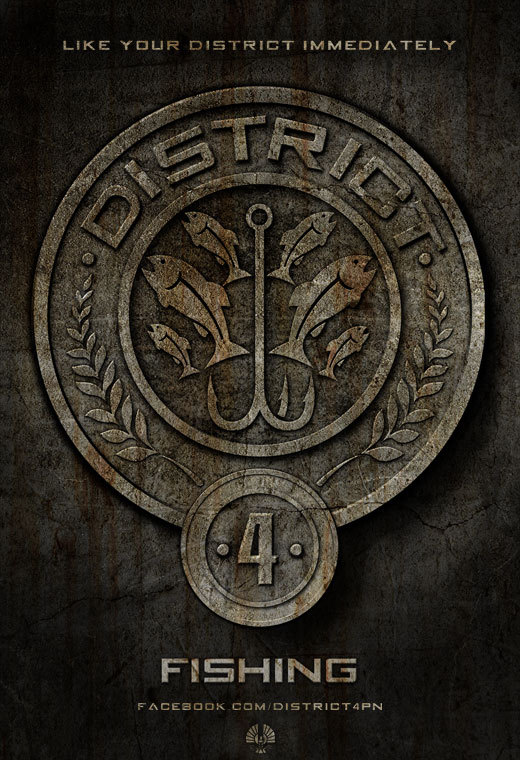
4. Godly Parent (Percy Jackson)

5. Middle Earth Race (Lord of the Rings)

6. Noble House (Game of Thornes)

7. Court (A Court of Thorns and Roses)

8. Intergalactic Planet (Star Wars)

9. Vampire Power (Twilight) - Beauty

10. Grisha Order (Grishaverse)

#the ultimate fictional classification#harry potter#hogwarts house#slytherin#divergent#faction#candor#the hunger games#district 4#percy jackson#dionysus#lord of the rings#men#game of thrones#house stark#acotar#spring court#star wars#alderaan#twilight#vampire powers#beauty#grishaverse#corporalki
3 notes
·
View notes
Text
Fontaine/ Genshin 4.0 Spoilers under cut
◇Really like how Ann calls Narcissus the 'Fell Dragon' even though they visually looks like an oceanid and another Rhodeia clone. Especially since it reminds me of a very silly headcanon I have about lochfolks, thunder manifestations and other potential sea angel-adjacent elemental beings.◇
◇Basically, I like to imagine that lochfolks, thunder manifestations and any similar beings (with exception to seelies and Paris) belong to a family which I call Manifestatiadae. Yes, it's most likely me being a speculative biology fan but eh.◇
◇Anyways, there's other members of manifestatiadae that aren't in the same Genus as lochfolks (Oceanid Sp.) , True manifestations (Manifestio sp.) And thylaflights/ Geo Manifestations (Geomanifestio Virgata). And there are a type of basal (I should mention that I HC Manifestations' ancestors to be vaguely Western dragon-like beings) manifestiadae known as Dracomimus, which are, of course, known as Dragon Mimics or Dracophius.◇
◇And one Dracomimus species is called Dracomimus Hydro, or Hydrophius. They're long, almost Eastern Dragon like manifestatiadae with large wings, long tail with many fins and lobed talons. And that fits Narcissus quite well! So now I want to doodle Narcissus as one of those guys... as well as U.N. Oceanid.◇
#《ocean's breeze》 ooc#Genshin spoilers#Genshin impact spoilers#Genshin 4.0#Fontaine#Genshin Narcissus#Genshin Ann#Ask to tag#genshin headcanons#speculative fiction#<- I guess?#◇I like taxonomy a bit too much◇#◇Maybe I should revamp my manifestation classification document◇#Long post
4 notes
·
View notes
Note
Ppl who say Yuri/yaoi/shoujo ai/shonen ai isnt gay/queer media are wild
Like sir... The girls and boys are falling in love and kissing. That's literally the girls and boys falling in love and kissing genre WTF are you on abt.
Do ppl just think that japanese queer ppl and authors that just decided to write a cute love story with characters of the same gender don't exist????????? Do they???????????
I'm not sure what brought this on exactly but yeah lol. Lots of people excuse this shitty attitude by insisting that most manga doesn't count as real queer media because their authors are ~mainly cishet women~ ("Source?" "It was revealed to me in a dream") and it's. Soooo annoying andjkgg. Luckily this hasn't happened to any mangaka as far as I know, but it's especially crazy to me because in general this way of thinking leads to pressuring authors into forcefully coming out so that their art can have a "legitimate" reason to exist, which... what the hell are you doing!!!! And it's truly stupid to attack akchually cishet authors as well, dare I say especially when they're women. There's no point in making monsters and enemies out of people who are for the most part allies and whose art is a way for them to reclaim their own sexuality, like there's no point in going after them because their works can be problematic™ or whatever else (boy is there Stuff out there made by queer people themselves!!!). Nevermind that more often than not hating on "fujoshi" is also an excuse to be super transphobic...
As a side note, I don't want to be That Person, but while yuri is used alongside GL (girls' love), both shounen/shoujo ai and yaoi are used super improperly in the west- depending on the market you're referring to, BL (boys' love) and geikomi/gei comi (gay comics) are your go-to (geikomi also being known as bara in the west, although the latter isn't commonly used in Japan either). You can read a bit about it here if you're interested x x x x x x x !
#classifications aside i know that yaoi as a term especially is going through a renaissance of some sort in a meme-y way now#and it's. not that i'm Against it necessarily but what i always think is ''do they Know. is it happening with Awareness''#''they'' = general they!!!!!!!!#myasks#fiction talk#animanga
5 notes
·
View notes
Text
Past me deciding I’m gonna do a villain bio for each of class 1-A in the Zagreus au. listing all their canon character information, crimes ect
Present me currently crying over having to individually figure out how each member of class 1-a would become villains as well as looking up all their canon information and researching serious crime IRL and in fiction to charge them with.
#I’m only half way through with character information#got the canon bio stuff out of the way which was something#there’s so much extra world building for an au I’ve written maybe 3 k words for#I can’t help it it so much fun making the fictional prison to house tiny murder babies#bnha au#zagreus au#I’ve even made threat level classification because why not make more work for myself
11 notes
·
View notes
Text
Miss Hatchet, Kim Possible, the complexity of library classification, and technocratic libraries

Ms. Hatchett tells Kim that she has an overdue library book
Recently, I began watching Kim Possible for the first time, apart from one episode: "Overdue." I watched it before I began the series. When I first conceived this post, I thought that I would somehow change my opinion of Miss Hatchet. Long-time readers may recall I previously described her as a person who "rules the school library like a tyrant...[with] her own form of library organization." After watching the episode, I feel no differently about her as I did before. However, I would argue that her character and the plotline says a lot more about libraries than I had previously guessed, meaning that Hatchet is more than a smorgasbord of librarian stereotypes, especially when it comes to library classifications of materials within libraries themselves.
This post is reprinted from Pop Culture Library Review and Wayback Machine.
There is no doubt that this librarian is "wound pretty tight" as Ron, a friend of Kim Possible, and series protagonist with her, remarks later in the episode. She has strict rules, like having a zero tardiness policy when it comes to overdue books. She has an enormous amount of power in the school as she is able to suspend Kim from cheerleading because she has an overdue book! Yikes. All the students seem to fear her and she acts like a villain throughout the episode, first by making Kim shelve stacks upon stacks of books based on her own, and more complicated, library classification system, known as the Hatchet Decimal System (HDS). Second, she takes away Kim's communicator (equivalent to her cell phone) and makes her put adhesive labels on every book saying "property of MHS library." In the end, Ron appears to come to the rescue, returning the book, but it turns out that this is the incorrect one, as it releases evil spirits which terrify her and cause destruction to the library. Her fate after that is unknown. Presumably, Kim and Ron save her life, although that isn't shown on screen.
Even though she is one of the only Middleton High School staff employees shown in the show, Hatchet nothing much more than a basket of stereotypes harmful to librarians while acting like a supervillain of sorts, giving Kim busy work while in "library lockup," as she calls it. Nothing about her is redeemable. However, I would venture that the episode is pointing to something more: the complexity of library classification. This has been an argument that has been rightly pointed out about the Dewey Decimal Classification system (DDC) have made in the past. This is despite the fact that this library classification system organizes to materials by subject. It can be hard for those who don't know the intricacies of DDC, like ordinary library patrons, to understand how books are organized. [1]
In 2007, the Library of Congress warned of limiting the use of the number components field so that doesn't become "confusing and complicated." Some years earlier, scholars Luc Beaudoin, Marc-Antoine Parent, and Louis C. Vroomen described DDC as a huge and complex information hierarchy. [2] Additional classification systems have also been noted as complex. For instance, some said that the Library of Congress Classification System (LCC) [3] is more efficient and specific for new technical material and big collections but "more complex." Others described the effort by Belgians Paul Otlet and Henri La Fontaine, who used the DDC as a basis, to create the "complex multidimensional indexing system" known as the Universal Bibliographic Repertory (UBR). [4]
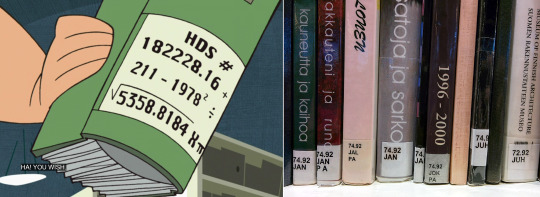
The Hatchet Decimal System on a book binding on the left and the DDC on a book bindings on the right. The latter is from this image on Wikimedia.
To come back to the episode, I would say that the focus on a classification system that Hatchet made by herself is meant to point to the complexity of library classification systems in general and how they can be confusing for ordinary people, in this case Kim. Her system is clearly more complex than the DDC and perhaps that is part of the point of this episode, which was written by Jim Peterson, directed by Steve Loter (who directs many of the episodes in the series), and storyboarded by Eugene Salandra, Jennifer Graves & Robert Pratt. It is incredible that Hatchet has enough authority that she can create her own system for organizing books in the library, which has become "her natural habitat" as it states on her short Kim Possible fandom page. Many librarians would not have that ability as their actions would be hemmed in by school administrators, school boards, national and state library associations, which have their own codes of ethics.
As Anne Gooding-Call has pointed out, "librarians of color don’t necessarily have the same support that white librarians enjoy," with the MLIS and middling wages as a barrier to many. This is undoubtedly the case for Hatchet, who the school probably would have treated differently had she been Black, Latine, or Asian, for instance, as most of the librarian field is composed of White female librarians. She would not have the social support of other White people, even if the students feared her. In one way, the library that Hatchet occupies appears to be a white space, meaning somewhere that Black people may be reluctant to ask questions or use resources. On another, since students generally fear her, no one, of any race, may be asking her questions or for any help. Instead, they are presumably trying to spend the least amount of time in the library as possible, as they are afraid of her. I would even argue that if she wasn't White, she couldn't be as mean and menacing to the students, at least I would hope that would be the case.
Beyond this, there is no doubt in my mind that Hatchet obviously blatantly violates tenets 1, 6, 7, 8, and 9, at minimum, of the ALA's Code of Ethics. This is not unique to her, as others are even worse offenders. [5] For instance, Francis Clara Censorsdoll in Moral Orel dipped "objectionable" books in kerosene and set them on fire. Cletus Bookworm in Rocky & Bullwinkle had no problem with an armed man taking two patrons of the library hostage. In fact, he encouraged their capture and applauded it. That's just two of the most egregious examples I can think of, although there are many others. Gooding-Call says that librarians are mostly "sincere people who mean well...eager to grow and improve" who can become "vehicles of empowerment." Hatchet does not seem to be this at all. Instead, she seems overly strict and harsh, not wanting to improve. She is the female equivalent of Steven Barkin, a former U.S. Army Ranger, who has a gruff, no-nonsense, attitude, and is abrasive with students in the series. Unlike Barkin, it is unlikely she has PTSD from wartime experiences.
There is the additional issue that the DDC system and other cataloging approaches were "designed in a racist and white-centered system," [6] building upon my post in May about fictional acceptance of the DDC. Hatchet probably didn't care much about this. Instead, what matters to her was lording this power over other people in a menacing way, or at least it appears that way. She says as much, as she declares to Kim that "There will come a day when you forget to return a book and I'll be waiting for you." It gives you the chills. Was she so self-centered that she created her own classification system? Did she care that DDC is, as Emily Ruth Brown points out, built around adult disciplines, is proprietary, and is negatively affected by changes in technology? We can't know for sure, as she is a one-time character who never re-appears in the series. This isn't surprising, given that Western animation has a habit of easily playing into librarian stereotypes, although this may be changing, with libraries shown much more positively in anime.
As I expected, not one person has written a fan fiction about Ms. Hatchet in Kim Possible on Archive of Our Own, even though it could make an interesting story to see things from her perspective. Clearly her actions toward Kim, and presumed other students, are irredeemable. Even so, she may be under a lot of stress as the only librarian of the entire Middleton High School library, at least the only one we see as the audience. If she had been trying to get Kim to do extra work, like shelving books, then this was definitely not the way to go about it. There are the other library scenes in the series, but she never re-appears. She is never given a chance to redeem herself or for the audience to see who she is as a person. She is just a bunch of stereotypes all shoved into one person. I admit that I may be reading too much into this 11-minute episode. At the same time, this episode may be more than what it appears to be on the surface and interconnects with issues surrounding library classification systems and even broader issues within the library field itself.
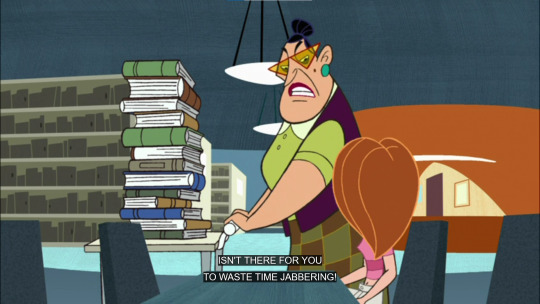
Ms. Hatchet pushes a book cart piled high with books
When I first composed and finished this post in later February 2022, my last paragraph was the end of the article. However, I see Hatchet's classification in a new light after reading a chapter by Rafia Marza and Maura Seale about White masculinity and "the technocratic library of the future" in Topographies of Whiteness. Although she is no technocrat, and neither are any of those on List of fictional librarians I have put together for this blog as most are either "old-school", "traditional", or "magical" for the most part, her complex HDS is akin to technocratic ideas. Marza and Seale note that as information technology has become a bigger part of librarianship in the 1990s and 2000s, the White female librarian has been replaced by ideas from Silicon Valley, with "technological solutions" which will supposedly free us. They further said that such a focus on technology as a "solution to complex social problems" is central to technocratic ideas, which is characterized by its "impartial, apolitical rationality," with those who are technocrats interests in politics rather than efficiency, thinking that technological fixes can be universal. However, this ideology is bound up in White supremacy because White men have historically claimed rationality and White masculinity has been able to function as the "universal form," while it can only claim to be neutral and objective due to Whiteness. At the same time it upholds patriarchy as well. [7] This interlinks with the historic investment of libraries in Whiteness and faulty notions such as rationality, objectivity, neutrality, and neoliberal tendencies. The latter is promoted by two ALA initiatives: Libraries Transform and the Center of the Future of Libraries (launched in 2015).
Such initiatives, Marza and Seale argue, engage internet-centrism, an idea described by Morozov as the idea that everything is changed and there needs to be fixes, while technology is permanent, fixed, has an inherent nature, and possess agency as it exists "outside of history." They are interconnected to technological solutionism, the idea that all complex social problems can be neatly defined and have definite solutions or processes that "can be easily optimized," even though this can undermine support for more demanding or stimulating reform projects. [8] This comes with the assumption that it is neutral and objective, even though it is anything but that. This is reinforced by a focus on digital and quantitative skills, with an individual and "entrepreneurial" worker as the default, who are often male and White, especially when it comes to those in Silicon Valley, who are used as a basis for these "necessary" skill sets. At the same time, care and emotion work, service work, manual labor, and so on are seen as "feminized labor" At the same time, libraries are seen as akin those businesses in the so-called sharing economy, with racial prejudice as ingrained in such an economy, and labor of people of color and White women not visible due to the emphasis on technology and de-emphasis on the labor behind the technology itself, with its deadly environmental and labor consequences. [9]
While labor of those causing the technological solutions to be workable is erased, so is any quiet or reflective work, like that portrayed in Kokoro Library, while fewer workers are told to take on more work, leading to burnout. Additionally, libraries are viewed as platforms, like the sites created by Silicon Valley, which ends up prioritizing monetization and obscures any libraries seen as "non-technological," pay is low, and librarianship itself is devalued while technocratic ideology is risen, and the value of library degrees has declined while information technology is seen as even more paramount. This is only strengthened with a focus on "short-term results," market demands, just-in-time services, efficiency, and "return on investment," even as emotional labor of women and physical labor of people of color is needed to make sure libraries, and society as a whole, function. In the end, such technocratic ideas are embedded in systems of privilege, while technology itself is subject to the same inequities as the rest of the world, with a necessary situated and historic understanding of technology and librarianship, and ways that both of those concepts "intersect with dominant conceptions of white masculinity." [10]
Hatchet clearly does not embody any of this technocratic ideology, nor has any librarian I've ever seen in any popular culture I've come across to date. However, her ideas would fit right in with today's technocratic push in librarianship, with their own inherent complexity. In fact, if the episode was to be done again today, it would not be a stretch to see Hatchet using robots to shelve the books in their own complex way, or even sitting at her desk while she ordered a robot to snatch Kim and bring her to the library in punishment for an overdue book. That may be a bit extreme, but the point is that her ideas fit within those who espouse technocratic ideas about libraries at the present. Ultimately, I enjoyed reexamining this episode and I look forward to your comments, criticisms, and anything else you'd like to leave in response to this post. Until next time!
© 2022 Burkely Hermann. All rights reserved.
Notes
[1] Erin Sterling, "The Case of the Clunky Classification: The Elusive Graphic Novel," May 2010, accessed February 25, 2022; "Dewey Decimal System," ScienceDirect, accessed February 25, 2022; "Information Literacy Tutorial: Finding Books," University of Illinois Library, University of Illinois, LibGuides, Aug. 7, 2018, accessed February 25, 2022; Melinda Buterbaugh, "Lesson Three: Dewey Decimal Classification (DDC) and Call Numbers," Library Practice 101, accessed February 25, 2022; "Teach Me How To Dewey," Hillsborough County, Florida, Dec. 13, 2017, accessed February 25, 2022; "Why I Would Use Dewey," Technical Processes for Education Media, Oct. 29, 2011, accessed February 25, 2022.
[2] Luc Beaudoin, Marc-Antoine Parent, and Louis C. Vroomen (1996), "Cheops: A Complex Explorer for Complex Hierarchies," IEEE, p. 87; "MARC DISCUSSION PAPER NO. 2007-DP06," Library of Congress, Jun. 6, 2007, accessed February 25, 2022.
[3] Not the same as the Library of Congress Subject Headings (LCSH) which has "been actively maintained since 1898 to catalog materials held at the Library of Congress" and said to be the "most widely adopted subject indexing language in the world." LCSH describes contents systemically, while LCC is a library classification system. Its also different from the Library of Congress Control Number (LCCN), a serially based system of numbering cataloged record.
[4] Robert McCoppin, "Who's killing the Dewey decimal system?," Chicago Tribune, Feb. 18, 2011, accessed February 25, 2022; Gerry le Roux, "Melvil Dewey and the classification of knowledge," Science Lens, Dec. 10, 2012, accessed February 25, 2022; ; "How the index card launched the information age," Multimediaman, Sept. 10, 2016, accessed February 25, 2022.
[5] Discounting the shushers, the most extreme include the librarian in multiple episodes of Kick Buttowski: Suburban Daredevil, Rita Loud in a Timon & Pumbaa episode ("Library Brouhaha"), Mr. Snellson in a Mysticons episode ("Happily Never After"), Librarian in a Big City Greens episode ("Quiet Please"), Librarian in a Courage the Cowardly Dog episode ("Wrath of the Librarian"), and Bat Librarian in Rise of the Teenage Mutant Ninja Turtles episode ("Mystic Library").
[6] "Conducting research through an anti-racism lens," University of Minnesota Libraries, University of Minnesota, Feb. 15, 2022, accessed February 25, 2022. Others have claimed that DDC can be reformed with librarians who have "deeply held values of equity, diversity, and inclusion" while others have pointed to racism within the DDC, by Dewey himself, noted Dewey was a sexual harasser and a clearly a bigot without any question. Even conservatives have pointed out that Dewey is ingrained in librarianship and there is no escaping him.
[7] Rafia Mirza and Maura Seale, "Who Killed the World?: White Masculinity and the Technocratic Library of the Future" within Topographies of Whiteness: Mapping Whiteness in Library and Information Science (ed. Gina Schlesselman-Tarango, Library Juice Press: Sacramento, CA: 2017), pp. 175-177. They also say on page 175 that in the early 20th century, librarians participated in "civilizing" and assimilating the "tired, huddled masses into American democracy" as long as those people could become White.
[8] Mirza and Seale, "Who Killed the World?", pp. 177-181. Libraries Transform describes itself as "spreading the word about the impact libraries and librarians make every day...[and] advocat[ing] for the value of librarianship" but the about page almost reads like a corporate webpage, and not surprising as Overdrive is the lead sponsor, with other big sponsors including Capital One, Dollar General, Biblioboard, and SAGE Publishing. The same can be said about the webpage of the Center of the Future of Libraries.
[9] Ibid, 181-5.
[10] Ibid, 186-192.
#kim possible#librarians#librarian stereotypes#stereotypes#library classification#libraries#fiction#pop culture#dewey decimal system#library of congress#loc#ethics#moral orel#rocky and bullwinkle#archive of our own#shushing
6 notes
·
View notes
Text
I just realised that if Fyodor is gone for good now it would mean us never learning about his ability. And that's not acceptable in a series about characters with supernatural abilities. Not acceptable at all.
#I need more information about what these abilities are and why they are and how they work#curse the magic system I installed in my fictional universe and making it into a science#but I've been assigning bsd characters abilities types and classifications based on that world's magic system for a few days now#and I'm losing sanity because I know how my world's energy works and how it manifests as magic and filters through people like lenses#while bsd's special abilities are an entire mess with no discernable pattern#other than 'related to famous works of the authors the characters are based on' and I don't know what that means about the world they're in#one option is that it's exactly what it is. a book.#but we have examples of characters IN THE BOOK creating worlds or spaces by writing a book#and that suggests it's in a lineage of worlds created by writers from 'higher' worlds#one of which is us#and this would mean we're ALSO in a book written by someone#and my head hurts
0 notes
Text
It's time for Waffles to come home. Maybe he's not Max's right-hand man -- er, bear -- anymore, but he's too good of a friend to not be anyone's right hand bear. So now, he belongs to one of the most important people in Max's life.
#ao3#fan fiction#stranger things#classification au#little! billy hargrove#caregiver! steve harrington#max mayfield#nsap#fandom#age regression#insomniacwriter17#fic links
10 notes
·
View notes
Text
"the magnus protocol had a whole ARG beforehand? what?"
yes! it did!
"oh so I need to have participated in this whole big thing to actually understand the podcast?"
not at all! from the official post-mortem put out by RQ, "while the ARG was not something that was necessary to participate in to understand the magnus protocol, it was designed to contain a wealth of background story and context that would enrich any player's listening experience."
"a wealth of background context that would enrich my listening experience 👀👀👀 how can I learn about this?"
SO glad you asked. sadly, many of the materials made for the arg have been taken down since the game ended 😔 (ex., the official OIAR, magnus institute, and bonzoland websites. (edit ii: I found partial wayback machine captures! see below) though @strangehauntsuk is still up!), so we're a bit low on primary sources, but in terms of learning about what happened:
for a starting point, I would really recommend this video by @pinkelotjeart
youtube
it's super accessible, it was made in real time as the game progressed and follows the solving and revelation of clues as they happened, it hits all the major points of the mystery and moments of community insanity while eliding some of the nitty gritty puzzle grinding, 10/10 would recommend.
here's the official summary put out by RQ, and I'd recommend reading through this once you've already gotten a basic handle on the flow of the story and the basic connections between major clues and events. it's got some fun behind-the-scenes info and lays out the thought process behind the puzzles in simple terms
here's the full masterdoc of all puzzles and resolutions put together in the statement remains discord server. masterdoc my absolute BELOVED, masterdoc my bethrothed, masterdoc my soul mate. I'd recommend this as a second port of call after the above video as it either contains all details about the puzzles or links to other expanded docs that do.
here's the narrative summary doc that lays out all the plot and lore discovered in three pages of plain prose. if you just want to get to the good bits as fast as you can and get blasted directly in the face by contextless lore bombs, this is the doc for you. if you don't want to start with the video, I'd say this is another good entry point.
once you've got the lay of the land, some of the game materials that I found particularly interesting include:
the in-universe east germany expat usenet forum, with all content translated into english. most of it is irrelevant space filler with occasional extremely sus lore, but I still found it fun to read through. love to soak in some fictional forum drama.
chdb.xlsx, the spreadsheet of the names of all the children the protocol 'verse magnus institute was studying/experimenting on. EDIT: here is a version of the sheet without any annotations and with all of the names in their original order, kudos to @theboombutton for catching that the commonly shared copy had the order swapped around.
klaus.xls, a (very corrupted) spreadsheet with what looks like the classifications of a bunch of old OIAR cases.
EDIT: have a few more saved materials from the game that I forgot to include.
an in-universe audio ad to apply to the OIAR that ran before archives episodes and kicked off the whole game.
an in-universe video ad to apply to the OIAR, this one is an official upload that's still up from the game itself. you can subscribe to the OIAR's official youtube channel today, if you so chose.
the robo-voicemail greeting from the OIAR's phone line.
EDIT II:
here is a wayback machine capture of the OIAR's official website.
here is a wayback machine capture of the bonzoland website.
(pretty sure both of the above captures just archived the home pages, though I haven't tried clicking all of the links. I'd say they're still worth looking at, the home pages give a good window into the vibes.)
once you start poking around in these documents, you'll find a bunch of links to others with further information, the materials I've included here just contain what I feel to be the most relevant details to getting a broad feel for the whole game. once again, huge shout out to the statement remains server, I was barely in there as the ARG was in progress and only ducked my head in every so often to find links like these. true mvps of the fandom.
#gonna pin this for a bit because every day I get 2-5 asks saying 'there was an arg? how do I learn about it?'#tmagp#video#marina marvels at life
5K notes
·
View notes
Text
A Workshop for Creating Magical/ Fictional Crystals: A Guide from a Geologist
Hi folks, its me, here to talk about fictional writing again! Today I'm just tackling the idea of magical stones/mana stones by looking at existing minerals today and some neat properties that they have, and how you can apply these things to a fictional world. The goal is mainly to help you if you are stuck trying to come up with a unique magic system, or a unique identification/characteristic of your mineral.
First Things First: Mineral Shapes

I am exhausted, petered out, down-right fatigued by seeing every mineral depicted with having the crystal structure of calcite and quartz. There are soooooo many cooler, more interesting crystal structures, don't you think you would stop and take a look at a perfect cube in nature? It is completely unsettling.
Second: Color
Color within minerals can either be really important, or not important at all! It is your choice to decide if color is going to be something that means something to your mineral. But what are some times when the color is important? Well.... there are some elements that are called chromophores, this classification just indicates that these elements, when present, will determine the color of whatever they are in. So, if you wanted to treat mana like a chromophore, you could say, "Oh everything that contains mana turns green!" This could mean that regardless of the mineral, if that mineral is a specific color, it means it contains mana. This concept is exciting because you can just stop here and use minerals that already exist! You can also use it as an indicator for a magical ore! Chromophores are typically metals, so if you are making a new metal weapon, making the ore of that metal a unique color would make a lot of sense!
However, your mineral can also just be every color of the rainbow like quartz and perhaps that's what makes identifying your mana stones elusive and create an illusion of scarcity that your character can solve.

There are other things that can change the colors of minerals, like radiation damage, and electron exchange, but I think that is beyond what would be helpful! So lets talk about some unique color properties that happen in nature that seem magical in the first place! Maybe you don't need to design a mana stone, but you want a unique gemstone that only the royal family passes down or something (IDK).
The first one is the alexandrite effect! This is where a mineral can change color in natural light vs. incandescent light. (the mineral itself is not changing, but the lights contain different amounts of different colors that then get absorbed by the stone). Even if you don't use electricity in your fictional world, you could have the colors change in the presence of light magic. This could create fun misunderstandings about what the mineral is reacting to!
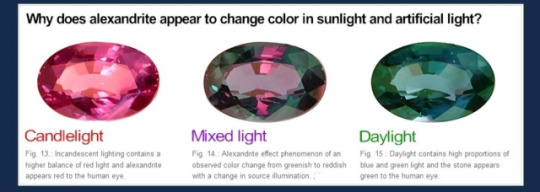
Pleochroism
Pleochroism is something that most minerals have, it is frequently used to help identify minerals in thin sections, however minerals are usually not pleochroic enough for it to be visible to the naked eye! Pleochroism is just a fancy name to describe the change in how light is absorbed based on the angle of the mineral! So if you scroll up to the first image where I showed a lot of crystal shapes, most of them have angles where they are longer and shorter! This will effect the way light travels in the crystal. Tanzanite is a popular mineral that does this.

Photochromism
This is when a mineral will change color (in a reversible way) when exposed to UV light (or sunlight), I am not going to go too into the details of why this is happening because it would require me to read some research papers and I just don't feel like it. The mineral that is best known for this is Hackmanite!

Alright! These are all the really cool color effects that might inspire you or maybe not, but now I am going to talk about how you might find your minerals within a rock!
When I see a lot of magical caves/mines, typically I see them with some variation of a geode honestly, but most minerals are not found like that! Now I am sure most of you guys have seen a geode, so I will not really talk about those, but I will talk briefly about porphyroblasts which is when the mineral grows larger than the minerals around it, this happens in metamorphic minerals!

sorry random stranger, but this is an image of garnets inside a finer-grained rock at gore mountain in New York!
Another way you might find minerals is in a pegmatite! This is when all minerals are really large! This is a formed from really slow crystalizing magma!


But something else to think about is that your mineral might just be massive, it doesn't have to have distinct crystals, it may be similar to jadeite where small grains grow together which leaves it looking smooth and seamless! A note about all of these is that you would have to mine into the rock to find these, there would not be any natural caves in these rocks! Caves are only ever really formed in limestones and maybe marbles (rocks that react with acid).

How can your characters identify these minerals?
Typically when you are out in the field you will look to see what type of rocks the minerals are found in (The overall texture of the rock will tell you how it formed). If you know how the rock formed, it will narrow down the amount of minerals you need to think about by quite a bit! Next, you are going to look closely at it and observe its crystal structure, does it have an obvious crystal? if so what is the general shape? If it is broken, how did it break? Did it fracture like glass or did it break along uniform planes. Some minerals have a thing called cleavage (breaks along planes of weakness). If a mineral exhibits this habit, it will again help narrow this down. Next we can look at color. Color can be misleading, because minerals like quartz can be any color imaginable, but minerals like olivine will always be green! The next thing your character can do is test for hardness, minerals all have a specific hardness that can help identify it as well.
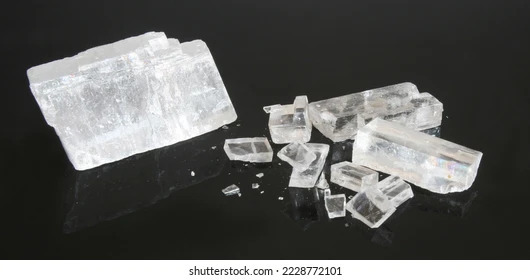
After you go through all of this, your mineral might have some special property! This could be magnetism, fluorescence, reactions to acid, or any of the color changing effects I mentioned above! Other than that, your character can take it back to a lab and do a number of things to identify it, but the most typical thing would be for them to make a thin section (very thin piece of the rock) and observe it under a cross polarized microscope!

On that note folks! I hope this helped in some way in thinking of new magic mineral properties! I have other guides that explore some different fictional worldbuilding issues you might run into, but if you have any topics you would like me to cover please that I haven't mentioned already, let me know!
#geology#rocks#creative writing#fictional world#worldbuilding#dnd#dnd worldbuilding#worldbuilding stuff#writing resources#info post#information#writing
4K notes
·
View notes
Text
Restricted Worlds are fictions that are particularly dangerous to new and middling Crossrunners. Mostly these are composed of M-rated games/R-rated media in Reality, but some T/PG-13 and even the rare G-rated game/media end up with this classification. Indeed, there is some debate among higher ups about G-rated games that should be here which are currently labelled as General Worlds.
0 notes
Text
𝑻𝒉𝒆 𝑯𝒊𝒅𝒅𝒆𝒏 𝑳𝒆𝒈𝒂𝒄𝒚: 𝑺𝒘𝒂𝒍𝒍𝒐𝒘𝒆𝒅
𝒎𝒂𝒈𝒊𝒄 𝒄𝒍𝒂𝒔𝒔𝒊𝒇𝒊𝒄𝒂𝒕𝒊𝒐𝒏𝒔
story project: the hidden legacy
lore of the elemental abilities within the story.
────────────────────────────────────────────
ʟᴜᴄɪᴀɴ ᴛʜᴀʟʟᴇʀ [ɪᴄᴇ/ᴡᴀᴛᴇʀ]
cyrokinesis: control ice, snow and other forms of frozen water.
frigokinesis: control snow either as precipitation or already on the ground.
ice generation and manipulation: generate ice from water by freezing it.
hydrokinesis: manipulate and control liquid water and mold it into any desired shape or form.
water generation: can generate water from surrounding sources (deep water wells, soil, dew).
────────────────────────────────────────────
ꜱᴀɴɪʀᴀ ᴍʏʀᴇ [ʟɪɢʜᴛ]
dark and white light manipulation: creating the darkest and lighest light in existence.
photokinesis: create and manipulate pure light.
invisibility: be unseen.
force-field generation: create protective shields of solid protons.
light absorption and generation: absorb the light surrounding and emit the light.
projective invisibility: can turn other things invisible.
────────────────────────────────────────────
ꜱᴛᴇᴘʜᴀꜱ ᴍʏʀᴇ [ᴅᴀʀᴋ]
dark and white light manipulation: creating the darkest and lighest light in existence.
umbrakinesis: can manipulate and control darkness or shadows.
light absorption: block out light in an area.
night vision: see in the dark.
shadow camouflage: be unseen in shadows.
shadow mimicry: become a shadow.
umbrageous teleportation: teleport via the shadows.
────────────────────────────────────────────
ᴇꜱᴛʏɴ ᴄᴏꜱᴛᴀʏɴᴇ [ꜰɪʀᴇ]
pyrokinesis: create, control, and manipulate fire, flame and heat.
geothermokinesis: manipulate lava, magma and volcanoes.
heliokinesis: manipulate and control the sun and sunlight.
inflammation: burn objects.
melting: healt molecules to heat things.
thermokinesis: create, control, and manipulate heat.
────────────────────────────────────────────
ᴄᴀᴇʟᴀɴ ʀʏᴋᴋᴇʀ [ᴇᴀʀᴛʜ]
geokinesis: control, manipulate, and reshape the earth at will.
crystallokinesis: manipulate minerals and crystals.
fraxikinesis: manipulate burnt matter.
geothermokinesis: manipulate, control, and create lava, magma and volcanic hydrovents.
golem creation: creation of golems out of rocks, wood, plants or magma.
koniokinesis: manipulate and control dust particles.
terrakinesis: control, manipulate and alter/reshape the surrounding terrain and landscape at will.
psammokinesis: control and manipulate sand.
────────────────────────────────────────────
ᴄᴀʀʏꜱꜱ ʜᴀꜱᴛᴡʏᴄᴋ [ᴀɪʀ]
aerokinesis: manipulate the air, wind, smoke and fog.
wind generation: create blasts of air.
electrokinesis: control, generate or absorb lightning.
telekinesis: movement of objects.
quintessence force generation: generation of whitish-blue lightning.
#the hidden legacy#swallowed#thl#elemental#magic#fantasy#young adult#fiction#magic classification#story
0 notes